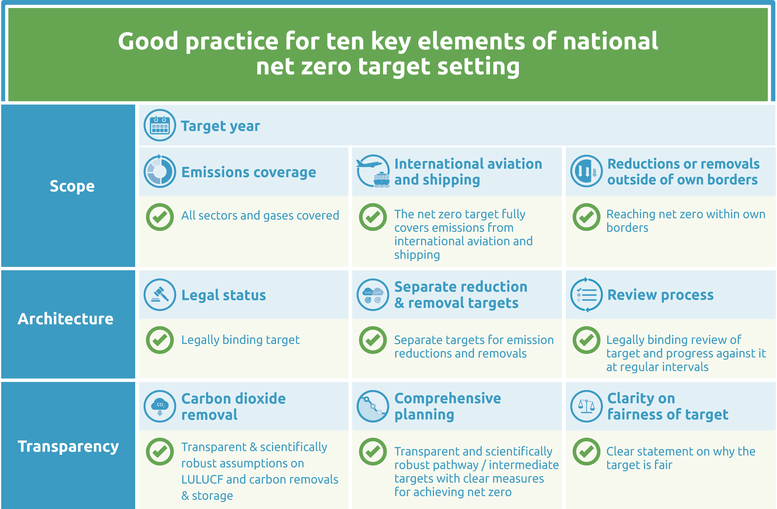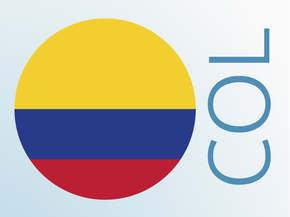Net zero targets
We evaluate Colombia’s net zero target as "Acceptable".
Colombia has a 2050 net zero GHG emissions target, which has been enshrined in domestic law – Ley de acción Climática (Law 2169, 2021). In November 2021, Colombia submitted its long-term Climate Strategy E2050 to the UNFCCC. The strategy includes a pathway to reach the 2050 target and outlines nine strategic initiatives with 48 transformation options for decision-makers to consider.
To achieve carbon neutrality by 2050, GHG emission are planned to be reduced by 90% from 2015 levels while the remaining 10% will be balanced with absorptions from national removal methods. The methods considered to cover the residual 10% are primarily nature-based removals (turning the LULUCF sector into a net sink) but also include technological options such as carbon capture and storage (CCS) for hard-to-abate sector.
Colombia’s long-term climate strategy includes different development scenarios that were estimated based on variations in economic growth, population, the cost of electric mobility, renewable energy and carbon capture technologies, as well as different global climate change scenarios impacting the Colombian hydrological systems. Through a system of nine “stakes”, the strategy presents a set of actions and technology choices to achieve decarbonisation of Colombia’s economy. However, the E2050 allows a continued role for fossil fuels in the Colombian energy matrix.
CAT analysis of net zero target
Ten key elements
Scope
- Target year – Colombia aims to reach net zero GHG emissions by 2050 – through the Climate Action Law (Law 2169, 2021).
- Emissions coverage – The target covers all GHG emissions and sectors of the economy – through the Climate Action Law (Law 2169, 2021).
- International aviation and shipping – The 2021 Climate Action Law does not make any reference to international aviation and shipping.
- Reductions or removals outside of own borders – Colombia plans to reach net zero emissions through domestic action (Gobierno de Colombia, 2021).
Target architecture
- Legal status – Colombia enshrined its net zero target into law in December 2021 (Law 2169, 2021). It also submitted its long-term strategy to the UNFCCC in November 2021.
- Separate reduction & removal targets – Colombia aims to reduce GHG emissions by around 90% compared to 2015 emissions and balance the remaining 10% primarily with nature-based removals (turning the LULUCF sector into a net sink) but also include technological options such as carbon capture and storage (CCS) for hard-to-abate sectors (Gobierno de Colombia, 2021).
- Review process – Colombia stated in Art. 24 of the Climate Law that from 2023 onwards and every two years, the Inter-sectoral Commission on Climate Change will review the results from monitoring the state of compliance in order to make adjustments to the implementation and adoption of new measures if necessary.
Transparency
- Carbon dioxide removal – Colombia is transparent in its estimated emissions reductions through actions in the LULUCF sector and stated that further action is needed to reach net zero as 14 to 32 MtCO2e would need to come from increased sinks. It also aims to achieve further reductions through carbon removals and storage, but this is currently not clearly quantified.
- Comprehensive planning – The Strategy include a defined pathway to reach the 2050 target and outlines nine strategic initiatives with 48 transformation options for decision-makers to consider. Further, Art. 23 of Law 2169 establishes the mandate to develop an implementation and monitoring plan, and Art. 24 mentions the minimum components that the plan should include – Ley de acción Climática (Law 2169, 2021).
- Clarity on fairness of target – Colombia E2050 long-term strategy mentions that Colombia is one of the most exposed countries to climate change and that its share of global emissions is 0.6% of total CO2 and that its contribution is in line with science and the global goal of limiting warming to 1.5 ̊C above pre-industrial levels.
Good practice
The Climate Action Tracker has defined the following good practice for all ten key elements of net zero targets. Countries can refer to this good practice to design or enhance their net zero targets.
Further analysis
Country-related publications
Stay informed
Subscribe to our newsletter

